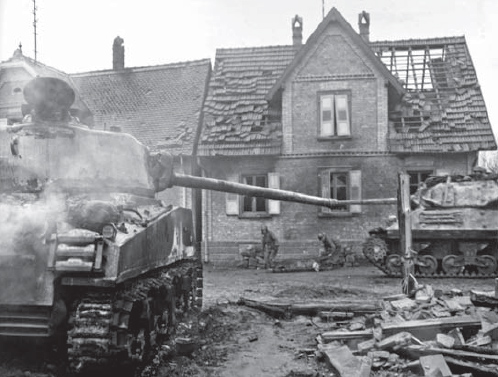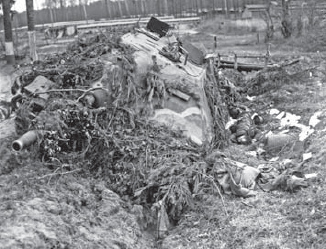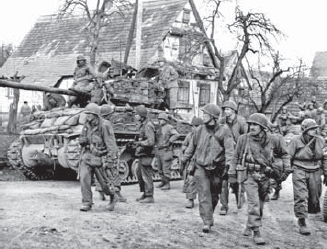
The German Sylwester offensives were the death rattle of the Wehrmacht in the west. After these misguided attacks, the Wehrmacht would never again be able to conduct anything but local counterattacks in the west because all of its operational reserves had been spent or shipped off to the east. The attacks were originally conceived as an adjunct to the Ardennes offensive with an aim towards tying down US forces. This mission became moot when Patton’s Third Army shifted its forces against Bastogne starting on December 19, long before Heeresgruppe G could initiate any actions in Alsace. By this stage of the war, the US Army had far quicker operational response times than the Wehrmacht, which was hamstrung both by a lack of fuel and predatory Allied air attacks against its transportation network. By the time that Nordwind started in Alsace on New Year’s Day, Devers’ 6th Army Group was already in a defensive posture and the fate of the Ardennes offensive had already decisively shifted against Germany. The original rationale for the Sylwester offensives had evaporated. The Wehrmacht reflexively continued its Alsace counteroffensive heedless of whether it had any plausible operational goal. Hitler had grown increasingly nihilistic after the failure of the Ardennes attack, and accepted a bloody battle of attrition as reason enough to continue the Alsace fighting. This made little sense in the conditions facing the Wehrmacht in Alsace in January 1945 where the Allies had artillery superiority as well as good defensive positions, and the Wehrmacht was attacking with weak, second-rate infantry in adverse terrain and weather conditions with little Panzer support and pathetically thin stocks of artillery ammunition. Such fighting inevitably caused significant casualties on both sides, but the outcome was seldom in doubt. As an attritional struggle, the Sylwester offensives cost the Wehrmacht far more than it cost the Allies.

After a two-week lull while the Colmar Pocket was being cleared, VI Corps stepped up its efforts to clean up unfinished business in early February by clearing the northern end of the Gambsheim bridgehead while the French 3e Division d’Infanterie Algérienne cleared the south. Oberhoffen, held by 10. SS-Panzer-Division during the process of being relieved by a Volksgrenadier division, was the center of much of the fighting that involved the 14th Armored Division and 36th Division on the American side. Here, an M4A3 (76mm) burns in the foreground as medics evacuate casualties under the cover of an M10 3in. GMC on February 3, 1945 during an action by the 142nd Infantry, 36th Division. (NARA)

Following the reduction of the Colmar Pocket, the Seventh Army stepped up its efforts to erase the German advances in the initial stages of Operation Nordwind. The fortress city of Bitche was finally taken and this heavily camouflaged Jagdpanzer 38(t) Hetzer assault gun was knocked out during the fighting there in early March 1945 by XV Corps. (NARA)

In March, Seventh Army continued its thrust northwards through the Low Vosges into the Saar. Here, troops of Combat Command A, 14th Armored Division pause in Oberlauterach on March 18, 1945. The heavy losses of tanks to German Panzerfaust antitank rockets during street fighting in Alsatian towns like Hatten, Rittershoffen, and Hillersheim prompted the Seventh Army to start a crash program to fit sandbag armor to its tanks as seen here. (NARA)
The fighting in Alsace in January also deprived the Wehrmacht of the time and the resources to prepare for the inevitable battle for Germany. This was most clear in the case of AOK 1 in the Saar on the north of Patch’s Seventh Army. AOK 1 had been bled white in the Nordwind fighting, and in February and March began to face the simultaneous encroachment of both Patton’s Third Army from the west and Patch’s Seventh Army from the south. Furthermore, because of the geography, Patch’s penetration of the Westwall meant that the Seventh Army could roll up the Rhine Valley behind the sector being attacked by Patton’s Third Army, completely undermining the last major defensive barrier in front of Patton’s troops. The result was the disastrous “Rhine Rat Race” in mid-March when AOK 1 simply disintegrated in front of Patton, vacating the entire Saar-Palatinate in hardly a week of desultory fighting. The destruction of AOK 19 in January 1945 and AOK 1 in March 1945 left southern Germany completely exposed to the advance of Patton’s Third Army and Patch’s Seventh Army and it is little surprise that the deepest and fastest Allied advances in April–May 1945 were in southern Germany.